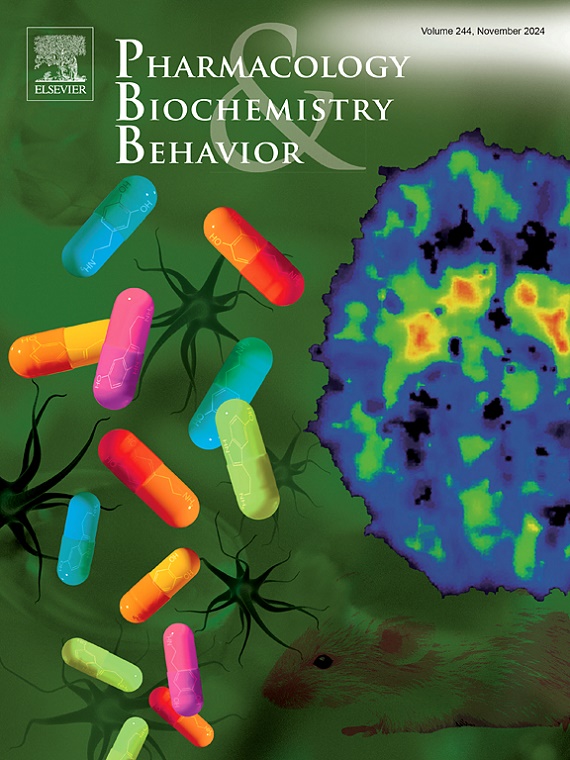Allosteric modulation of M1 or M4 muscarinic receptors restores eNOS expression and L-arginine metabolism in dementia models and synergizes with NO releasers
IF 2.5
3区 心理学
Q1 BEHAVIORAL SCIENCES
引用次数: 0
Abstract
Background
Positive allosteric modulators (PAMs) of muscarinic receptors (M) have been shown to effectively prevent cognitive dysfunctions associated with dementias, but little is known about their impact on NO֗-dependent pathways, in particular eNOS expression, L-arginine metabolism and its derivatives (ADMA/SDMA/NMMA) production.
Methods
Biochemical studies were performed in frontal cortices, hippocampi and plasma samples from mice that were administered with MK-801 (schizophrenia-related dementa) or scopolamine (Alzheimer's disease model) for 14 days alone or together with muscarinic receptors modulators: VU0357017 (M1) and VU0152100 (M4). Western blot was used to measure eNOS, DDAH1 and PRMT5, while mass spectrometry was used to measure the levels of L-arginine derivatives. Behavioral studies aimed to investigate the procognitive effects of the combined administration of PAMs with NO• releasers, spermineNONOate or DETANONOate were performed in novel object recognition (NOR) test, in scopolamine- or MK-801- induced amnesia.
Results
Our results indicate that MK-801 or scopolamine disturb eNOS, DDAH1, PRMT5 expression, and L-arginine bioavailability. VU0357017 or VU0152100 prevented scopolamine or MK-801-induced eNOS dysfunction, but L-arginine derivatives synthesis was inhibited only in MK-801 model. Synergistic effect with NO֗ releasers was observed in NOR.
Conclusions
eNOS expression and L-arginine bioavailability may contribute to antipsychotic action of VU0357017 or VU0152100. The antialzheimer's effect to a lesser extend involves normalization of L-arginine metabolism. The joint administration of the compounds with NO֗ releaser could be proposed as synergistic treatment for both schizophrenia and Alzheimer's disease.
M1或M4毒蕈碱受体的变构调节恢复痴呆模型中eNOS的表达和l -精氨酸代谢,并与NO释放物协同作用
毒蕈碱受体(M)的阳性变构调节剂(pam)已被证明可以有效预防与痴呆相关的认知功能障碍,但对其对NO 依赖途径的影响知之甚少,特别是eNOS表达、l -精氨酸代谢及其衍生物(ADMA/SDMA/NMMA)的产生。方法用MK-801(精神分裂症相关性痴呆)或东莨菪碱(阿尔茨海默病模型)单独或与毒碱受体调节剂VU0357017 (M1)和VU0152100 (M4)联合给药14天,对小鼠额叶皮质、海马和血浆样本进行生化研究。Western blot检测eNOS、DDAH1和PRMT5,质谱法检测l -精氨酸衍生物水平。在东莨菪碱或MK-801诱导的健忘症中,行为学研究旨在探讨PAMs与NO•释放剂、精胺烯酸盐或去氨酸盐联合使用对认知的促进作用。结果MK-801或东莨菪碱干扰eNOS、DDAH1、PRMT5的表达和l -精氨酸的生物利用度。VU0357017或VU0152100均能抑制东莨菪碱或MK-801诱导的eNOS功能障碍,但仅在MK-801模型中抑制l -精氨酸衍生物的合成。在NOR中观察到与NO释放剂的协同作用。结论:VU0357017或VU0152100的抗精神病作用可能与senos表达和l -精氨酸生物利用度有关。抗阿尔茨海默病的作用在较小程度上涉及到l -精氨酸代谢的正常化。与NO释放剂联合给药可作为精神分裂症和阿尔茨海默病的协同治疗。
本文章由计算机程序翻译,如有差异,请以英文原文为准。
求助全文
约1分钟内获得全文
求助全文
来源期刊
CiteScore
6.40
自引率
2.80%
发文量
122
审稿时长
38 days
期刊介绍:
Pharmacology Biochemistry & Behavior publishes original reports in the areas of pharmacology and biochemistry in which the primary emphasis and theoretical context are behavioral. Contributions may involve clinical, preclinical, or basic research. Purely biochemical or toxicology studies will not be published. Papers describing the behavioral effects of novel drugs in models of psychiatric, neurological and cognitive disorders, and central pain must include a positive control unless the paper is on a disease where such a drug is not available yet. Papers focusing on physiological processes (e.g., peripheral pain mechanisms, body temperature regulation, seizure activity) are not accepted as we would like to retain the focus of Pharmacology Biochemistry & Behavior on behavior and its interaction with the biochemistry and neurochemistry of the central nervous system. Papers describing the effects of plant materials are generally not considered, unless the active ingredients are studied, the extraction method is well described, the doses tested are known, and clear and definite experimental evidence on the mechanism of action of the active ingredients is provided.

 求助内容:
求助内容: 应助结果提醒方式:
应助结果提醒方式:


